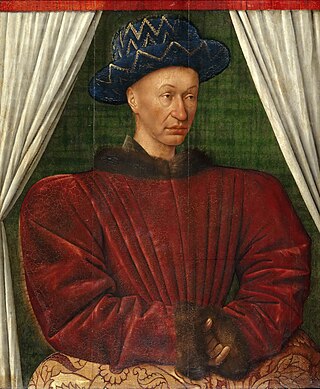
Dauphin of France, originally Dauphin of Viennois, was the title given to the heir apparent to the throne of France from 1350 to 1791, and from 1824 to 1830. The word dauphin is French for dolphin and was the hereditary title of the ruler of the Dauphiné of Viennois. While early heirs were granted these lands to rule, eventually only the title was granted.

Charles VII, called the Victorious or the Well-Served, was King of France from 1422 to his death in 1461. His reign saw the end of the Hundred Years' War and a de facto end of the English claims to the French throne.

The Dauphiné, formerly known in English as Dauphiny, is a former province in southeastern France, whose area roughly corresponded to that of the present departments of Isère, Drôme and Hautes-Alpes. The Dauphiné was originally the Dauphiné of Viennois.

The Duke of Aquitaine was the ruler of the medieval region of Aquitaine under the supremacy of Frankish, English, and later French kings.

Michelle of France, also called Michelle of Valois, was Duchess consort of Burgundy as the first wife of Philip III, Duke of Burgundy, called "Philip the Good". She was born a princess of France as the daughter of Charles VI, King of France and Isabeau of Bavaria.
Duke of Valentinois is a title of nobility, originally in the French peerage. It is currently one of the many hereditary titles claimed by the Prince of Monaco despite its extinction in French law in 1949. Though it originally indicated administrative control of the Duchy of Valentinois, based around the city of Valence, the duchy has since become part of France, making the title simply one of courtesy.

John, Dauphin of France and Duke of Touraine was Dauphin of Viennois and Duke of Touraine. He inherited the Dauphin of Viennois in 1415, following the death of his older brother, Louis. He died 5 April 1417, and was succeeded by his brother Charles.

Duke of Touraine was a title in the Peerage of France, relating to Touraine.
Louis, Dauphin of France, or variations on this name, may refer to:
Charles of France might refer to:

Louis was the eighth of twelve children of King Charles VI of France and Isabeau of Bavaria. He was their third son and the second to hold the titles Dauphin of Viennois and Duke of Guyenne, inheriting them in 1401, at the death of his older brother, Charles (1392–1401).

Margaret of Nevers, also known as Margaret of Burgundy, was Dauphine of France and Duchess of Guyenne as the daughter-in-law of King Charles VI of France. A pawn in the dynastic struggles between her family and in-laws during the Hundred Years' War, Margaret was regarded as the future Queen of France at two separate times, as a result of her two marriages: first to the Dauphin and second to the Duke of Brittany.

Humbert I of Viennois was baron of la Tour-du-Pin and then also became, by his marriage, dauphin of Viennois. He was the son of Albert III, baron of la Tour-du-Pin, and of Béatrice de Coligny.
Adémar II de Poitiers, known in Old Occitan as Ademar or Aimeric de Peiteus, was the count of Valentinois and de facto ruler of Diois from 1188 or 1189 until 1230. He was the son of Count Guillaume and grandson of Count Adémar I. He married Philippa, daughter of Guillaume-Jourdain, the lord of Fay, and Météline de Clérieu. The Finnish scholar Aimo Sakari hypothesised that Philippa of Fay was the famous trobairitz known as the Comtessa de Dia, and that the friend (amic) mentioned by the Comtessa in her poems was the troubadour Raimbaut de Vaqueiras. Around 1195–96, Adémar himself participated in a three-way torneyamen with Raimbaut de Vaqueiras and Perdigon.

Count of Die, Diois or Dyois is a title of nobility, originally in the French peerage.

Louis I de Poitiers, Count of Valentinois, was a 14th-century French noble. Louis was killed during the Battle of Auberoche in 1345.

Aymar VI de Poitiers, known as "Le Gros", Count of Valentinois and Diois, Lord of Taulignan and Saint-Vallier, Governor of Dauphiné from 1349 to 1355, he was appointed in 1372, Rector of the Comtat Venaissin, by his brother-in-law Pope Gregory XI. He was deputy to Jean de Cheylar, prior of Charraix, near Langeac, in the bishopric of Saint-Flour.












